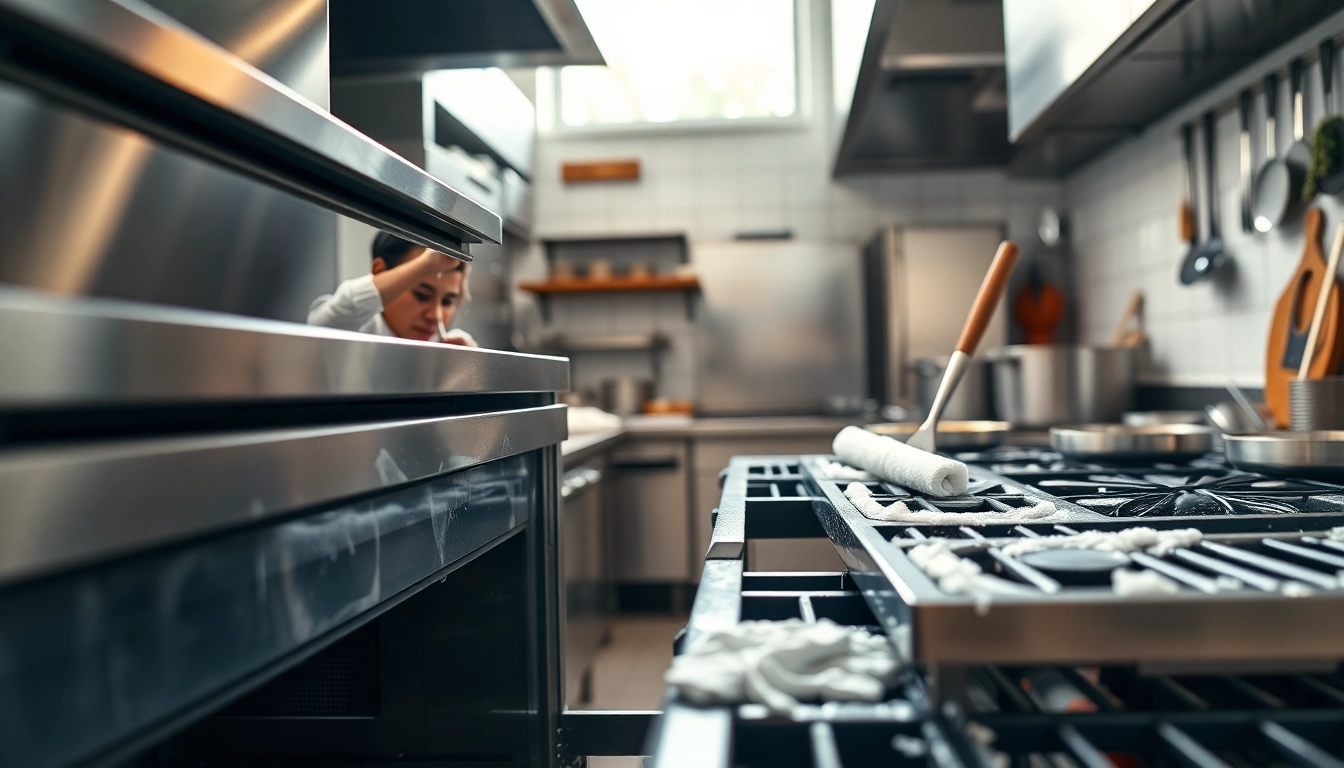Understanding the Importance of Restaurant Cooking Appliance Cleaning
In the fast-paced environment of a restaurant kitchen, maintaining a clean and hygienic space is essential, particularly when it comes to Restaurant Cooking Appliance Cleaning. The efficacy of cleaning not only affects food safety but also has broader implications for the operation of the business, public health, and customer satisfaction. This comprehensive guide dives deep into why regular cleaning is vital, common risks of neglect, essential tools and practices, and more, ensuring your restaurant remains compliant and efficient.
Why Regular Cleaning is Vital for Safety and Compliance
Regular cleaning of cooking appliances is crucial for ensuring food safety and regulatory compliance. Contaminated appliances can lead to foodborne illnesses, resulting in dire consequences for both customers and the restaurant. The U.S. Centers for Disease Control and Prevention (CDC) state that millions of Americans fall ill due to foodborne illnesses each year, making it imperative for restaurants to adhere to strict cleaning protocols.
Cleansing these appliances routinely not only adheres to local health codes but also cultivates a safer cooking environment. Appliances such as ovens, fryers, and grills can become breeding grounds for bacteria if not cleaned consistently. Moreover, health inspections often evaluate cleanliness as a primary factor in establishing compliance status, which can directly impact a restaurant’s reputation and operational capabilities.
Common Risks of Neglecting Appliance Maintenance
When appliance maintenance is neglected, several risks emerge that can jeopardize not only the kitchen’s hygiene but also the overall restaurant operations:
- Food Contamination: Bacteria, grime, and debris can contaminate food, leading to serious health risks for consumers.
- Equipment Malfunction: Caked-on grease or debris can lead to appliance failure, increasing repair costs and downtime.
- Fire Hazards: Accumulated grease can become a significant fire risk in commercial kitchens, where the likelihood of a fire from cooking equipment is heightened.
- Regulatory Penalties: Frequent health code violations due to poor cleanliness can result in fines or temporary closure.
How Cleaning Affects Appliance Longevity and Efficiency
Adequate cleaning practices can significantly improve the longevity and efficiency of restaurant cooking appliances. Grease build-up can not only hinder functionality but can also result in higher energy consumption and increased wear and tear. Regular maintenance allows appliances to operate more efficiently, which can decrease energy bills and extend the life of the equipment.
For instance, ovens that are cleaned regularly distribute heat evenly, leading to better cooking results, while fryers that are maintained can achieve a quicker response time to temperature control.
Essential Tools and Supplies for Effective Cleaning
A successful cleaning regime for restaurant cooking appliances requires the right tools and supplies. Below, we explore the must-have cleaning supplies and innovative tools that can greatly enhance cleaning efficiency.
Must-Have Cleaning Equipment for Restaurant Cooking Appliances
- Scrub Brushes: Different types of scrub brushes for varying surfaces are essential to tackle stubborn grime.
- Microfiber Cloths: Ideal for wiping down surfaces, microfiber cloths are effective for picking up dirt and grease without leaving residue.
- Pressure Washers: Great for deep cleaning large equipment like grills and fryers, pressure washers can expedite the cleaning process.
- Vacuum Cleaners: Specialized vacuums can help in removing grease and debris from hard-to-reach areas.
Choosing the Right Cleaning Chemicals for Different Surfaces
Selecting the appropriate cleaning chemicals is vital for maintaining the integrity of appliances. Different surfaces require specific products to ensure effective cleaning without damaging the material. For example:
- Stainless Steel: Use pH-balanced cleaners that are specifically designed for stainless steel to prevent tarnishing.
- Cast Iron: Avoid abrasives; opt for gentle cleaners paired with oil to maintain seasoning.
- Teflon or Non-Stick Surfaces: Use soft sponges and cleaners that are specifically marked as safe for non-stick coatings.
Always refer to manufacturer recommendations for cleaning solutions to avoid voiding warranties or causing damage.
Innovative Tools to Enhance Cleaning Efficiency
Advancements in cleaning technology have produced numerous innovative tools that can streamline the cleaning process:
- Steam Cleaners: These are effective in sanitizing surfaces without the need for harsh chemicals and can cut down on manual scrubbing time.
- Cleaning Robots: For larger establishments, utilizing robotic cleaners can maintain floors and certain surfaces autonomously, ensuring they remain clean while focusing manpower on more intensive cleaning tasks.
- Automated Cleaning Notifications: Smart technology can remind staff when cleaning is due based on usage patterns and schedules.
Step-by-Step Guide to Cleaning Common Restaurant Cooking Appliances
Now that you have the right tools and supplies, let’s move on to a detailed guide on how to clean specific appliances found in restaurants.
Best Practices for Cleaning Ovens and Ranges
Cleaning ovens and ranges is crucial for food safety and appliance efficiency. Follow these steps for effective cleaning:
- Turn Off and Cool Down: Ensure the oven is turned off and allowed to cool completely before cleaning.
- Remove Loose Debris: Use a vacuum or cloth to take away loose food particles and debris.
- Use the Right Cleaner: Depending on the oven type (conventional, convection, etc.), apply a suitable oven cleaner and let it sit according to product instructions.
- Scrub The Interior: With an appropriate scrub brush, scrub the surfaces to remove grime. Avoid using metal scrubbers as they can scratch surfaces.
- Clean The Racks: Soak oven racks in hot, soapy water before wiping them down with a non-abrasive cloth.
- Final Wipe: Wipe down all surfaces with clean, damp cloths to remove any residual cleaner.
How to Properly Clean Fryers and Griddles
Cleaning fryers and griddles ensures optimal performance and food safety. Here’s how:
- Turn Off and Drain: Ensure the fryer is off and drained of oil before cleaning.
- Soak Parts: Remove parts that can be detached and soak them in hot, soapy water while the fryer cools.
- Scrub Grates and Surfaces: Use commercial griddle cleaners or degreasers along with a scrub pad designed for non-stick surfaces.
- Rinse Thoroughly: After scrubbing, rinse all parts with clean water to eliminate soap residue.
- Dry Completely: Make sure all components are dried completely before reassembling to prevent oil contamination.
Techniques for Caring for Convection and Steam Ovens
Convection and steam ovens require special care. Follow these techniques for effective cleaning:
- Utilize Self-Clean Options: Many convection ovens have a self-cleaning mode that can assist in breaking down debris.
- Clean Water Reservoirs: Ensure that water reservoirs are emptied and cleaned frequently to prevent build-up of lime.
- Wipe Down External Surfaces: Utilize a mild, non-abrasive cleaner to wipe down the exterior to maintain appearance and hygiene.
Formulating a Cleaning Schedule to Maintain Hygiene Standards
A structured cleaning schedule is vital for sustaining hygiene standards in the kitchen. Implementing an effective cleaning routine charts the course for operational success.
Daily, Weekly, and Monthly Cleaning Tasks
Establishing a clear cleaning protocol can ensure that tasks are not overlooked:
- Daily Tasks:
- Wipe down surfaces and cooking appliances.
- Clean floors and remove trash.
- Sanitize utensils and food contact surfaces.
- Weekly Tasks:
- Deep clean fryers and griddles.
- Descale appliances if necessary.
- Inspect and clean hoods and vents for grease accumulation.
- Monthly Tasks:
- Conduct a thorough inventory of all cleaning supplies.
- Perform maintenance checks on critical appliances.
- Evaluate operational effectiveness and compliance adherence.
Integrating Staff Training for Consistent Cleaning Practices
Training employees on proper cleaning methods is essential for consistency. Regular sessions and refreshers can ensure everyone understands the cleaning standards expected:
- Offer hands-on demonstrations for each appliance and cleaning technique.
- Implement regular assessments of cleaning practices.
- Encourage feedback from staff to identify potential gaps in procedures.
Tracking Cleaning Compliance and Audit Readiness
Establishing a tracking system for cleaning tasks and compliance can aid in prompt action and readiness for audits. Consider:
- Utilize checklists that staff can complete to mark when tasks are done.
- Conduct regular internal audits to ensure protocols are being followed.
- Keep records of cleaning processes for review during inspections.
Measuring the Impact of Cleaning on Restaurant Operations
Regular cleaning practices can have a profound impact on the operation of a restaurant. Understanding these impacts can help validate the importance of thorough cleaning regimens.
Analyzing Efficiency Improvements Post-Cleaning
Post-cleaning performance assessments should be conducted to identify efficiency improvements. Metrics can include:
- Reduction in appliance downtime due to maintenance issues.
- Decrease in energy consumption as a result of cleaner, more efficient equipment.
- Faster food preparation times attributed to streamlined operations post-cleaning.
Customer Perception: How Cleanliness Influences Dining Experiences
Bluedirect customer perceptions are closely tied to cleanliness. Insights from surveys indicate that a majority of diners prioritize cleanliness when selecting restaurants. Notable points include:
- Customers are significantly more likely to return to establishments that exhibit high cleanliness standards.
- Word-of-mouth referrals often include remarks about the cleanliness of the facilities.
- Failure to maintain cleanliness can lead to poor reviews and diminished reputation.
Tools for Monitoring Appliance Performance After Cleaning
Monitoring appliance performance helps validate the effectiveness of cleaning efforts. Consider utilizing the following tools:
- Temperature Monitoring Devices: Ensure appliances reach and maintain safe cooking temperatures.
- Energy Monitoring Systems: Track the energy usage of equipment and identify trends attributed to cleaning.
- Performance Logs: Maintain logs that document appliance performance pre and post-cleaning.
In conclusion, effective Restaurant Cooking Appliance Cleaning is integral to maintaining safety standards, enhancing efficiency, and delivering a positive dining experience. By integrating proper tools, techniques, and continuous training, restaurants can foster a culture of cleanliness that benefits both their operations and their customers.



